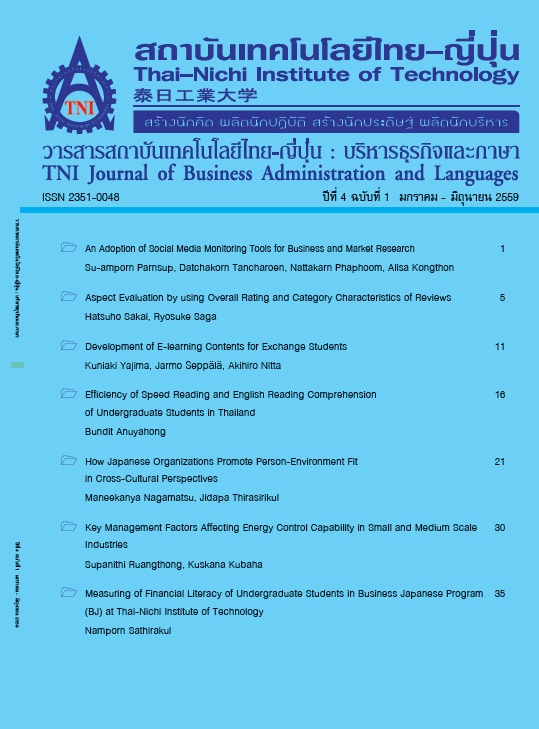Efficiency of Speed Reading and English Reading Comprehension of Undergraduate Students in Thailand
Main Article Content
Abstract
The purposes of this research were 1) to study speed reading efficiency of undergraduate students in Thailand, 2) to compare reading ability of undergraduate students before and after the class, 3) to compare reading ability of experimental group and control group according before and after the class, and 4) to study satisfaction with the method of speed reading of the undergraduate students
Research samples were 35 undergraduate students in higher education level derived through simple random sampling technique. The instruments used for gathering the data were speed reading materials, a reading test, and a satisfaction questionnaire. Statistics used for analyzing the data were frequency, percentage, mean, standard deviation, t-test, and content analysis.
Research findings were as follows:
- The reading efficiency of undergraduate students was at a moderate level.
- The scores of reading ability of undergraduate students after the class were higher that before the class with statistically significance at 0.05 level.
- The scores of reading ability of experimental group students were higher than control group students with statistically significance at 0.05 level.
- The students’ satisfaction towards the speed reading technique was highly positive.
Article Details
Article Accepting Policy
The editorial board of Thai-Nichi Institute of Technology is pleased to receive articles from lecturers and experts in the fields of business administration, languages, engineering and technology written in Thai or English. The academic work submitted for publication must not be published in any other publication before and must not be under consideration of other journal submissions. Therefore, those interested in participating in the dissemination of work and knowledge can submit their article to the editorial board for further submission to the screening committee to consider publishing in the journal. The articles that can be published include solely research articles. Interested persons can prepare their articles by reviewing recommendations for article authors.
Copyright infringement is solely the responsibility of the author(s) of the article. Articles that have been published must be screened and reviewed for quality from qualified experts approved by the editorial board.
The text that appears within each article published in this research journal is a personal opinion of each author, nothing related to Thai-Nichi Institute of Technology, and other faculty members in the institution in any way. Responsibilities and accuracy for the content of each article are owned by each author. If there is any mistake, each author will be responsible for his/her own article(s).
The editorial board reserves the right not to bring any content, views or comments of articles in the Journal of Thai-Nichi Institute of Technology to publish before receiving permission from the authorized author(s) in writing. The published work is the copyright of the Journal of Thai-Nichi Institute of Technology.
References
R. P. Carver, “Reading rate: Theory, research, and practical Implications,” Journal of Reading, vol. 36, no. 2, pp. 84-95, 1992.
W. Duanglit, “Effects of Using Constructed Instruction Based on Interesting to Students’ English Reading Skill Development,” M.S. Thesis, Dept. English, Graduate School of Mahasarakarm University, 2001.
D. Brown, Teaching by principles: An interactive approach to language pedagogy. Upper Saddle River: Prentice Hall Regents, 1994.
B. Khajonsil, Educational Research Methodology, 5th ed. Bangkok: P.N. Publishing, 2000.
J. W. Best, Research in Education, 5th ed. New Jersey: Prentice Hall Inc., 1981.
L. J. Cronbach, The Dependability of Behavioral Measurement Theory of Generalizability for Scores and Profile. New York: Wiley Press, 1974.
P. Thaweerat, Methodology of Behavioral and Social Sciences, 8th ed. Bangkok: Chareonphol Publishing, 2000.
E. Quinn, S. P. Nation, and S. Millett, Asian and Pacific speed readings for ESL learners: twenty passages written at the one thousand word level. Wellington: School of Linguistics and Applied Language Studies, Victoria University of Wellington, 2007.
K. Goodman, Reading, Writing, and Written Texts: A Transactional Sociolinguistic View. In R.B. Ruddell, M.R. Ruddell, & H. Singer (eds.) Theoretical models and processes of reading. Newark: International Reading Association, 1994.
E. Williams, Reading in the Language Classroom, 8th ed. London: MacMillan, 1994.
C. D. Mary and H. Mark, “The effect of reading speed and reading pattern on the understanding of text read from screen,” Journal Research Reading, vol. 23, no. 2, pp. 210-223, 2000.
T. Rasinski, A. Rikli, and S. Johnston, “Reading fluency more than automaticity? More than a concern for the primary grades?,” Literacy Research and Instruction, vol. 48, no. 4, pp. 350-361, 2009.
R. P. Carver, “Reading Rate: Theory, Research, and Practical Implications,” Journal of Reading, vol. 36, no. 2, pp. 84-95, 1992.


